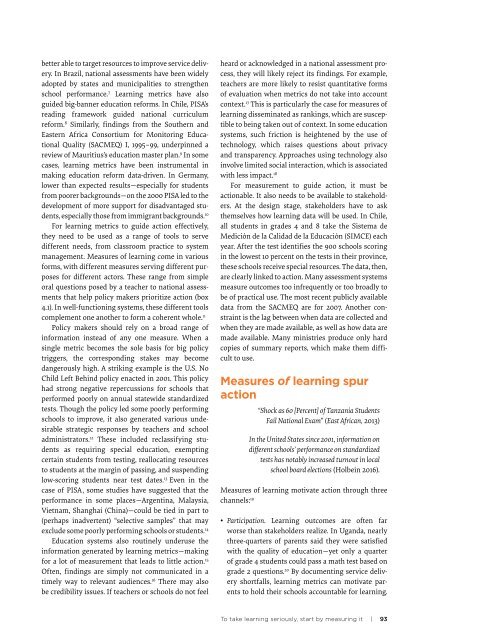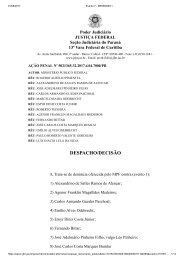Brasil só deve dominar Leitura em 260 anos, aponta estudo do Banco Mundial Relatorio Banco Mundial _Learning
Create successful ePaper yourself
Turn your PDF publications into a flip-book with our unique Google optimized e-Paper software.
etter able to target resources to improve service delivery.<br />
In Brazil, national assessments have been widely<br />
a<strong>do</strong>pted by states and municipalities to strengthen<br />
school performance. 7 <strong>Learning</strong> metrics have also<br />
guided big-banner education reforms. In Chile, PISA’s<br />
reading framework guided national curriculum<br />
reform. 8 Similarly, findings from the Southern and<br />
Eastern Africa Consortium for Monitoring Educational<br />
Quality (SACMEQ) I, 1995–99, underpinned a<br />
review of Mauritius’s education master plan. 9 In some<br />
cases, learning metrics have been instrumental in<br />
making education reform data-driven. In Germany,<br />
lower than expected results—especially for students<br />
from poorer backgrounds—on the 2000 PISA led to the<br />
<strong>deve</strong>lopment of more support for disadvantaged students,<br />
especially those from immigrant backgrounds. 10<br />
For learning metrics to guide action effectively,<br />
they need to be used as a range of tools to serve<br />
different needs, from classroom practice to syst<strong>em</strong><br />
manag<strong>em</strong>ent. Measures of learning come in various<br />
forms, with different measures serving different purposes<br />
for different actors. These range from simple<br />
oral questions posed by a teacher to national assessments<br />
that help policy makers prioritize action (box<br />
4.1). In well-functioning syst<strong>em</strong>s, these different tools<br />
compl<strong>em</strong>ent one another to form a coherent whole. 11<br />
Policy makers should rely on a broad range of<br />
information instead of any one measure. When a<br />
single metric becomes the sole basis for big policy<br />
triggers, the corresponding stakes may become<br />
dangerously high. A striking example is the U.S. No<br />
Child Left Behind policy enacted in 2001. This policy<br />
had strong negative repercussions for schools that<br />
performed poorly on annual statewide standardized<br />
tests. Though the policy led some poorly performing<br />
schools to improve, it also generated various undesirable<br />
strategic responses by teachers and school<br />
administrators. 12 These included reclassifying students<br />
as requiring special education, ex<strong>em</strong>pting<br />
certain students from testing, reallocating resources<br />
to students at the margin of passing, and suspending<br />
low-scoring students near test dates. 13 Even in the<br />
case of PISA, some studies have suggested that the<br />
performance in some places—Argentina, Malaysia,<br />
Vietnam, Shanghai (China)—could be tied in part to<br />
(perhaps inadvertent) “selective samples” that may<br />
exclude some poorly performing schools or students. 14<br />
Education syst<strong>em</strong>s also routinely underuse the<br />
information generated by learning metrics—making<br />
for a lot of measur<strong>em</strong>ent that leads to little action. 15<br />
Often, findings are simply not communicated in a<br />
timely way to relevant audiences. 16 There may also<br />
be credibility issues. If teachers or schools <strong>do</strong> not feel<br />
heard or acknowledged in a national assessment process,<br />
they will likely reject its findings. For example,<br />
teachers are more likely to resist quantitative forms<br />
of evaluation when metrics <strong>do</strong> not take into account<br />
context. 17 This is particularly the case for measures of<br />
learning diss<strong>em</strong>inated as rankings, which are susceptible<br />
to being taken out of context. In some education<br />
syst<strong>em</strong>s, such friction is heightened by the use of<br />
technology, which raises questions about privacy<br />
and transparency. Approaches using technology also<br />
involve limited social interaction, which is associated<br />
with less impact. 18<br />
For measur<strong>em</strong>ent to guide action, it must be<br />
actionable. It also needs to be available to stakeholders.<br />
At the design stage, stakeholders have to ask<br />
th<strong>em</strong>selves how learning data will be used. In Chile,<br />
all students in grades 4 and 8 take the Sist<strong>em</strong>a de<br />
Medición de la Calidad de la Educación (SIMCE) each<br />
year. After the test identifies the 900 schools scoring<br />
in the lowest 10 percent on the tests in their province,<br />
these schools receive special resources. The data, then,<br />
are clearly linked to action. Many assessment syst<strong>em</strong>s<br />
measure outcomes too infrequently or too broadly to<br />
be of practical use. The most recent publicly available<br />
data from the SACMEQ are for 2007. Another constraint<br />
is the lag between when data are collected and<br />
when they are made available, as well as how data are<br />
made available. Many ministries produce only hard<br />
copies of summary reports, which make th<strong>em</strong> difficult<br />
to use.<br />
Measures of learning spur<br />
action<br />
“Shock as 60 [Percent] of Tanzania Students<br />
Fail National Exam” (East African, 2013)<br />
In the United States since 2001, information on<br />
different schools’ performance on standardized<br />
tests has notably increased turnout in local<br />
school board elections (Holbein 2016).<br />
Measures of learning motivate action through three<br />
channels: 19<br />
• Participation. <strong>Learning</strong> outcomes are often far<br />
worse than stakeholders realize. In Uganda, nearly<br />
three-quarters of parents said they were satisfied<br />
with the quality of education—yet only a quarter<br />
of grade 4 students could pass a math test based on<br />
grade 2 questions. 20 By <strong>do</strong>cumenting service delivery<br />
shortfalls, learning metrics can motivate parents<br />
to hold their schools accountable for learning.<br />
To take learning seriously, start by measuring it | 93








